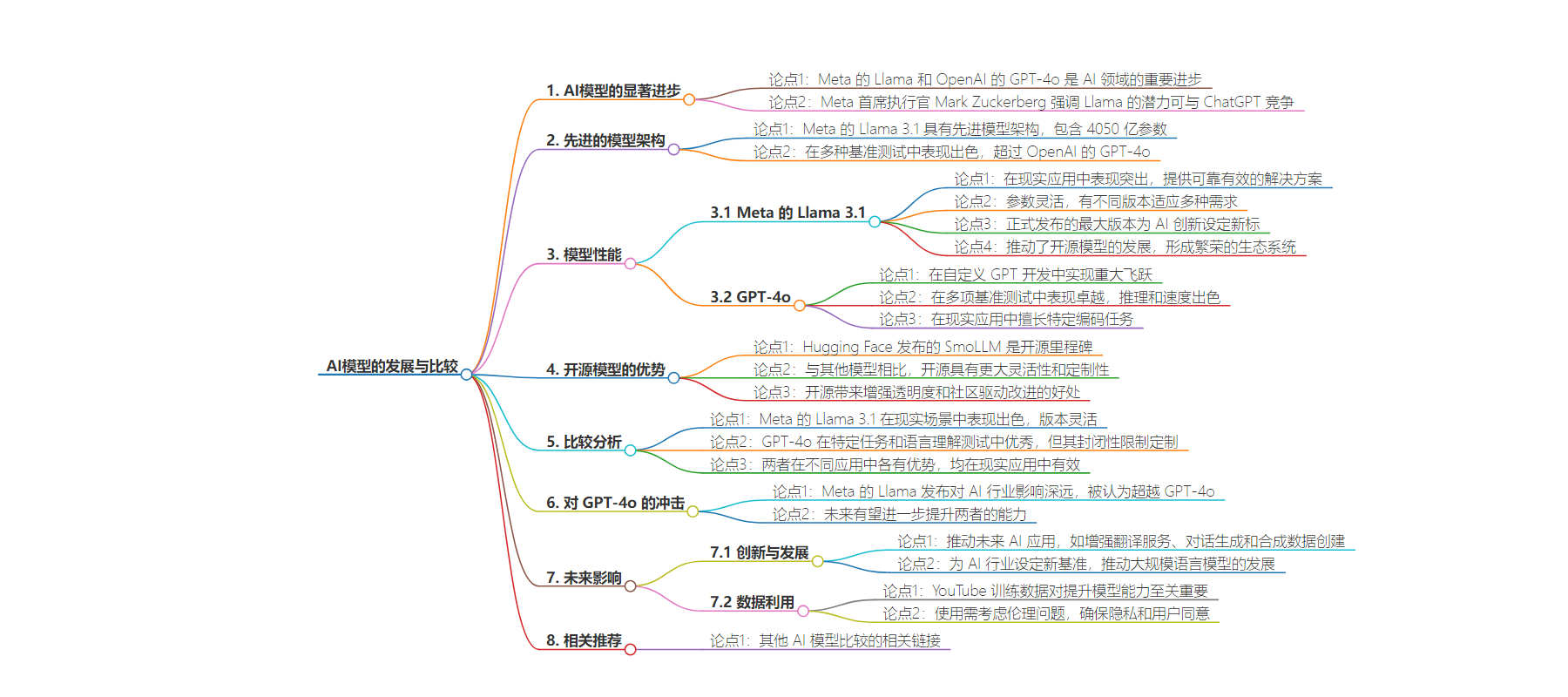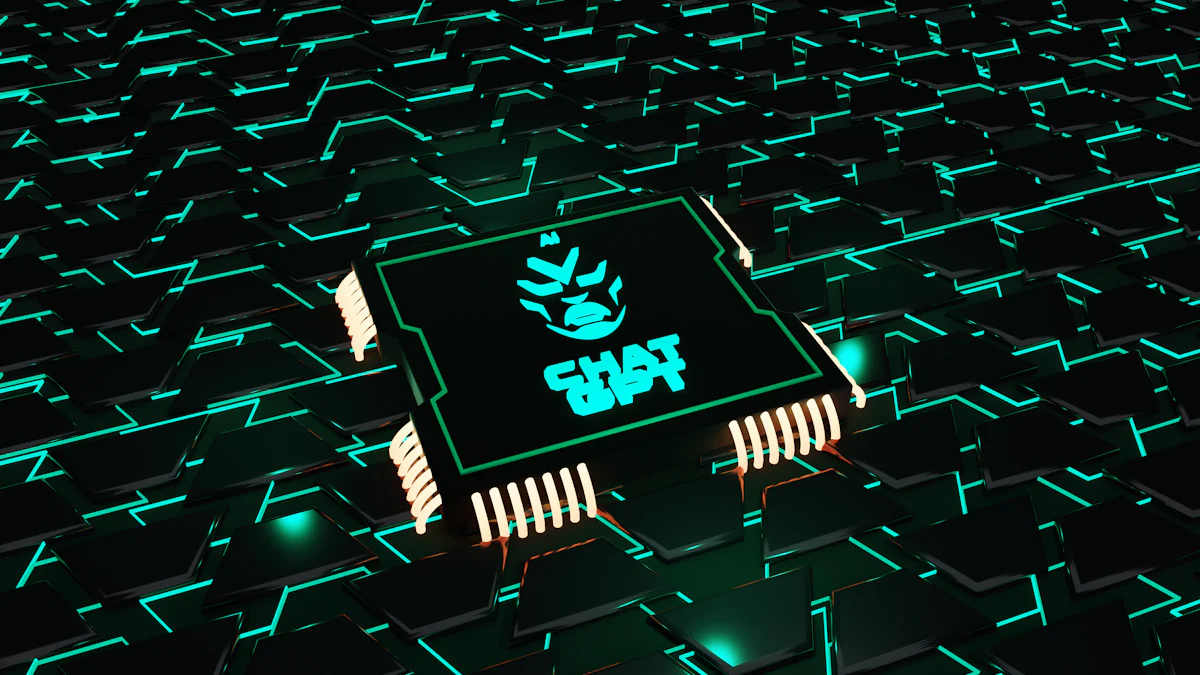包阅导读总结
1. 关键词:AI 模型、Meta’s Llama、GPT-4o、AI 创新、性能对比
2. 总结:
本文主要介绍了 Meta 的 Llama 3.1 和 OpenAI 的 GPT-4o 这两种 AI 模型,对比了它们的性能、架构、应用等方面,探讨了其对 AI 创新和行业标准的影响,还提到了利用 YouTube 训练数据的相关问题及未来展望。
3. 主要内容:
– Meta’s Llama 3.1
– 具有先进模型架构,包含 4050 亿参数
– 在多种基准测试中表现出色,超越 GPT-4o
– 有不同参数版本,灵活性强,应用广泛
– 正式发布,推动 AI 创新,形成繁荣生态
– GPT-4o
– 在定制 GPT 开发中有重大飞跃
– 在多种基准测试中表现优异,推理和速度出色
– 在特定编码任务和一般语言理解测试中表现良好
– 对比
– Llama 3.1 灵活,GPT-4o 封闭,限制定制
– 二者都有广泛用途
– 其他
– Hugging Face 发布的 SmoLLM 有开源优势
– 利用 YouTube 训练数据,需考虑伦理问题
– 未来这两种模型有望继续改进,推动 AI 应用发展
思维导图:
文章地址:https://myscale.com/blog/why-metas-llama-gpt-4o-matter-today/
文章来源:myscale.com
作者:MyScale Blog
发布时间:2024/7/23 19:45
语言:英文
总字数:1247字
预计阅读时间:5分钟
评分:87分
标签:Meta 的 Llama,GPT-4o,人工智能进展,开源人工智能,人工智能模型比较
以下为原文内容
本内容来源于用户推荐转载,旨在分享知识与观点,如有侵权请联系删除 联系邮箱 media@ilingban.com

Meta’s Llama and GPT-4o represent significant advancements in the field of artificial intelligence. Meta’s Llama 3.1, an Open-Source Language Agent, has shown superior performance in real-world scenarios. Meta chief Mark Zuckerberg highlighted its potential to rival ChatGPT. On the other hand, OpenAI‘s GPT-4o remains a benchmark (opens new window) for elite-level AI models. The blog aims to explore why these models matter today by examining their impact on AI innovation and industry standards.
Advanced Model Architecture
Meta’s Llama 3.1 showcases an Advanced Model Architecture that includes 405 billion parameters. This model architecture allows Meta’s Llama to exceed the capabilities of (opens new window) OpenAI’s GPT-4o by a few percentage points across various benchmarks, including reasoning tests. The Performance of Meta’s Llama demonstrates state-of-the-art capabilities in (opens new window) general knowledge, steerability, math, tool use, and multilingual translation.
The Performance of Meta’s Llama 3.1 stands out due to its superior real-world application results. The model offers reliable and effective solutions for diverse applications. The 405 billion parameters enable the model to handle complex tasks with ease, making it a formidable competitor in the AI landscape.
The flexibility of Meta’s Llama comes from its availability in different versions such as (opens new window) 8B, 70B, and 405B parameters. This range allows users to select the most suitable version for their specific needs. The diverse applications include synthetic data generation and AI assistant capabilities.
Meta Officially released the largest version of Llama, which has set new standards in AI innovation. The introduction of this model marks a significant milestone in AI development.
The release of Meta’s Llama has had a profound impact on AI innovation. It has pushed the boundaries of what is possible with open-source models, encouraging further advancements in the field.
The thriving Llama Ecosystem, supported by various versions like Llama Stack and Llama Guard, fosters an environment conducive to continuous improvement and innovation. The ecosystem includes tools such as Llama Stack API, which enhances usability and integration into different platforms.
GPT-4o Overview
Custom GPT
GPT-4o represents a significant leap in Custom GPT development. The model showcases Advanced capabilities, particularly in reasoning and speed. On the MMLU benchmark, GPT-4o scores 88.7%, a 2.2% improvement (opens new window) compared to GPT-4 Turbo. This improvement highlights the model’s superior performance metrics.
Performance Metrics
The performance of GPT-4o stands out due to its elite-level results across various benchmarks like HumanEval and MGSM. The model achieves scores above 85 on general language understanding tests, demonstrating its prowess in handling complex tasks. Compared to other models like Claude-3-Opus and Gemini, GPT-4o shows better reasoning capabilities and faster time to first token (opens new window) (TTFT).
Real-world Applications
In real-world applications, GPT-4o excels in specific coding tasks such as analyzing multimedia inputs and visual data. The model’s versatility makes it suitable for diverse use cases, from general language tasks to specialized functions in AI assistant roles.
Hugging Face Releases SmoLLM
The release of SmoLLM by Hugging Face marks another milestone in the AI landscape. This open-source initiative offers several benefits over proprietary models.
Comparison with Other Models
When comparing SmoLLM with other models, its open-source nature stands out as a significant advantage. Unlike closed systems, SmoLLM allows for greater flexibility and customization.
Open-source Benefits
The open-source benefits of SmoLLM, released by Hugging Face, include enhanced transparency and community-driven improvements. These features foster an environment conducive to continuous innovation and development within the AI ecosystem.
Comparative Analysis
Meta’s Llama 3.1 exhibits exceptional Performance in real-world scenarios. The Llama models offer flexibility with different parameter versions, such as 8B, 70B, and 405B. These variations cater to diverse applications. The officially released Llama model has set new benchmarks in AI innovation.
On the other hand, GPT-4o excels in specific coding tasks and general language understanding tests. The model powering ChatGPT achieves elite-level results across various benchmarks like HumanEval and MGSM. However, the closed nature of GPT-4o limits its customization options compared to open-source models like Meta’s Llama.
Both Meta’s Llama and GPT-4o serve a wide range of use cases. For instance, Meta’s Llama demonstrates superior capabilities in synthetic data generation and multilingual translation. The flexibility of the different parameter versions allows users to select the most suitable model for their specific needs.
In contrast, GPT-4o, a model powering ChatGPT, excels in analyzing multimedia inputs and visual data. This makes it ideal for specialized functions in AI assistant roles. Both models have proven effective in various real-world applications.
Dethrones GPT-4o
The release of Meta’s Llama has had a profound impact on the AI industry. Many experts believe that it has dethroned GPT-4o, indicating significant advancements in open-source AI models. The thriving ecosystem around the officially released Llama fosters continuous innovation.
Future developments will likely see further enhancements to both models’ capabilities. For example, improvements in aligned large language models could lead to more robust performance metrics for both Meta’s Llama and GPT-4o. Continuous updates will ensure that these models remain at the forefront of AI innovation.
Future Implications
Innovation and Development
Potential Future Applications
Meta’s Llama 3.1 and GPT-4o will drive future applications in artificial intelligence. These models will enhance translation services, dialogue generation, and synthetic data creation. The efficiency of Meta’s Llama will lead to more advanced AI assistants. The superior reasoning capabilities of GPT-4o will improve multimodal tasks involving text, images, audio, and video.
Role in AI Industry
The role of Meta’s Llama and GPT-4o in the AI industry cannot be overstated. These models set new benchmarks for open-source and proprietary systems. Their advancements push the boundaries of what is possible with large-scale language models. The continuous innovation from these platforms fosters a competitive environment that benefits the entire AI community.
Youtube training data
Data Utilization
The utilization of YouTube training data plays a crucial role in enhancing the capabilities of both Meta’s Llama and GPT-4o. Training on diverse content from millions of YouTube videos allows these models to understand various contexts better. This comprehensive dataset improves their performance across different real-world scenarios.
Ethical Considerations
Ethical considerations surrounding the use of YouTube training data are paramount. Ensuring privacy and consent when using such vast amounts of user-generated content is essential. Both Meta and OpenAI must adhere to strict guidelines to maintain ethical standards while leveraging this valuable resource.
Meta’s Llama and GPT-4o represent groundbreaking advancements in the AI field. Meta’s Llama 3.1, with its superior performance and flexibility, has set new standards for open-source models (opens new window). The diverse applications of Meta’s Llama, from synthetic data generation to multilingual translation, highlight its significance.
Key points discussed include the advanced architecture of Meta’s Llama, its impact on AI innovation, and the thriving ecosystem it supports. In contrast, GPT-4o excels in specific coding tasks and general language understanding tests but lacks customization options due to its closed nature.
Future outlook suggests continuous improvements in both models, driving further innovation in AI applications. Recommendations include leveraging these advancements responsibly while considering ethical implications related to training data utilization.
See Also
Faceoff: Moshi vs Gpt-4o in Today’s AI Battle (opens new window)
Revealing Gemma3 vs Llama3: AI Model Clash (opens new window)
Exploring Hugging Face’s GPT2 Model: The Magic Revealed (opens new window)
Snowflake Arctic vs. Llama3: The Ultimate Enterprise AI Faceoff (opens new window)
Microsoft Phi 3 Mini: Unveiling Efficient AI Solutions Inside (opens new window)
